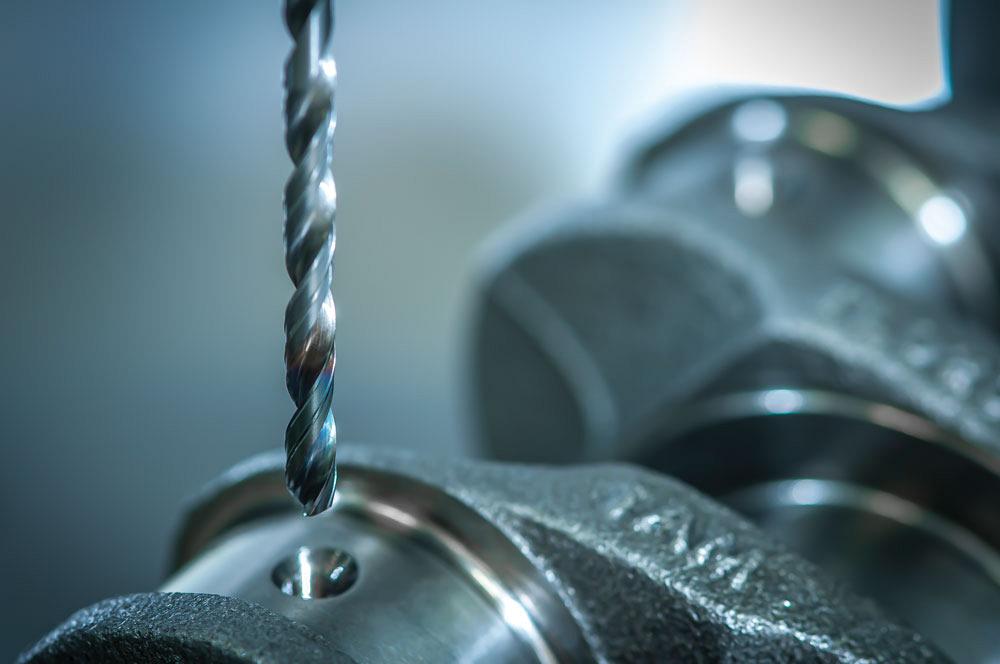Application Engineer
- FMA
- The Fabricator
- FABTECH
- Canadian Metalworking
Solving drilling problems
Challenges arising from drilling cross-, through-holes are minimized with proper tool strategy
- By Sam Matsumoto
- June 4, 2020
- Article
- Cutting Tools

Using the correct tool geometry and parameters reduce the common problems associated with drilling cross-holes.
Drilling through cross-holes and interrupted holes can present many challenges. Some machinists may find that their drill prematurely fails because of chipping on the corner of the drill. Others may struggle with exit burrs forming in the intersecting hole and hole inaccuracy.
Drilling cross-holes may sound problematic, but you have many strategies to choose from to reduce common problems and ensure the production of quality holes while preserving tool life.
Choosing a Drill
When drilling these types of hole, it is recommended that you use a double-margin drill. The double margin works to increase stability and effectively guide the drill through the interruption.
A single-margin drill has only two points of contact spaced 180 degrees apart, whereas a double-margin drill has four evenly spaced points of contact with the hole wall, creating a more effective guide for the drill.
A three-flute drill also has a similar effect, creating three even points of contact.
As for any drilling application, it is important to keep tool overhang length at a minimum, reduce runout, and ensure a rigid setup is in place.
Setting Parameters
When choosing parameters for the operation, your No. 1 course of action is to reduce the drill’s feed as it progresses through the interruption. The reduced feed not only reduces exit burrs, but it also is necessary when entering the surface on the opposite side of the cross-hole.
This is because the reduced chip load results in lower cutting forces on the drill, which helps increase stability and decrease deflection. It also helps compensate for the varying chip load that the drill would be subjected to when entering a non-flat surface.
Stability is crucial to ensuring the drill does not experience premature wear or chipping on its corners. Increased stability also helps ensure that a straighter, more concentric hole is created.
In most cases, choosing the proper type of drill and adjusting parameters are effective ways to reduce common problems associated with drilling cross-holes. When those two methods do not provide satisfactory results, however, you can introduce additional processes to improve hole quality.
For example, a flat-bottomed drill or end mill can be used to create a “spot face” for a pointed drill to enter the intersecting surface. Because the drill is now entering a flat surface, chip loads are even on the drill flutes, which helps ensure proper engagement and reduce the drill’s tendency to “walk.”
Adding this additional process is the most effective way of preserving tool life and mitigating quality problems, but it comes at the cost of longer cycle times. It is important to weigh the costs of potential scrap and tool expenditure against the cost of adding this additional process.
Going Deep
If you are using a long drill in a deep-hole application and have a long overhang, having a straight pilot/guide hole (1xD to 3xD deep and approximately 0.1 mm larger in diameter) for the long drill is a critical step in guiding the drill point straight into the work material.
Also, make sure the point angle of the pilot drill is the same or greater than the long drill. It’s necessary that the drill’s point engages first to ensure proper hole alignment.
If you use a 120-degree-point-angle pilot drill with a 140-degree long drill, the middle of the drill cutting edge will engage first, instead of the drill point, which may cause premature chipping, poor hole alignment, and, in the worst case, tool breakage.
Minimizing the overhang by picking the shortest possible drill for the application also is important.
Another application to be wary of is when you are using a small-diameter drill that has a long overhang. When there is a small diameter and long overhang, rigidity will decrease and the drill will become more prone to breakage if not properly set up.
Keeping Cool
For deep-hole drilling, having efficient coolant pressure is critical, especially for smaller through-coolant drills. Around 1,000 PSI is recommended, using a sealed holder as well.
Efficient coolant is needed to promote chip evacuation. Not only for chip evacuation, efficient cooling is necessary when you are drilling into materials that have a tendency to work-harden, such as 304 and 316 stainless steels and nickel-based alloys such as INCONEL, to prevent any issues for secondary processes such as reaming or tapping.
Although drilling cross-holes may seem intimidating, you can take various measures to ease the process.
Using the correct tool geometry, adjusting parameters, and adding supplementary processes are all simple ways to reduce common problems associated with drilling cross-holes. Correctly applying these methods will save you time, money, and the headache associated with machining these problematic features.
Sam Matsumoto is application engineer for OSG Canada, 538 King Forest Ct., Burlington, Ont. L7P 5C1, 905-632-8032, www.osgtool.com.
About the Author
subscribe now


Keep up to date with the latest news, events, and technology for all things metal from our pair of monthly magazines written specifically for Canadian manufacturers!
Start Your Free Subscription- Industry Events
MME Winnipeg
- April 30, 2024
- Winnipeg, ON Canada
CTMA Economic Uncertainty: Helping You Navigate Windsor Seminar
- April 30, 2024
- Windsor, ON Canada
CTMA Economic Uncertainty: Helping You Navigate Kitchener Seminar
- May 2, 2024
- Kitchener, ON Canada
Automate 2024
- May 6 - 9, 2024
- Chicago, IL
ANCA Open House
- May 7 - 8, 2024
- Wixom, MI




















